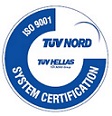Hospital-acquired infections in Greece: a real, but manageable problem
Hospital-acquired infections (HAIs) are infections that are acquired by patients during their stay in a hospital or health care facility. Based on recent data from the European Centre for Disease Prevention and Control (ECDC), approximately 6% of hospitalized patients in Europe develop HAIs. With the total number of patients with HAIs in Europe rising to 3.2 million for the year 2011-2012, it is clear that this is a major problem for public health. All hospitalized patients are potentially in risk of HAI, but the risk is particularly high in intensive care units (ICUs) where, according to European data, about 1 in 5 patients exhibits HAI. The majority of these infections is caused by bacteria that are resistant to antibiotics, as a result of the excessive use of antibiotics.
ECDC data shows that about 1 in 10 hospitalized patients (~9%) in Greece develops HAI, placing it among the European countries with the highest rate of HAI occurrence. The occurrence rate of HAIs is dramatically higher in ICUs for adults and newborns, reaching 50% and 30% respectively. Unfortunately, Greece ranks among the top countries in Europe in HAIs that are caused by resistant germs and first in the consumption of antibiotics in hospitals (54.7%).
The impact on patients and on the health system is significant, since it translates to prolonged stays of patients in hospitals, a dramatic rise in the cost of hospitalization, as well as an increase in mortality rates. Every year in Greece, HAIs are responsible for the death of 3,000 of our fellow citizens and correspond to a total cost of approximately 1.2 billion euros for the Greek health care system.
There are many factors that contribute to the increased risk for developing HAIs in Greece. One factor is the hospital environment (health professionals, medical tools, visitors, etc.). An equally important factor is the use of invasive instruments (urinary catheters, ventilators and central venous catheters). But, the most important factor is the lack of compliance of the healthcare professionals to simple standard practices, such as compliance with hand hygiene practices or with practices concerning the insertion and maintenance of invasive instruments (such as urinary catheters, central venous catheters and ventilators). Unfortunately, in Greece, compliance with hand hygiene is extremely low (approximately 33%) and seems to be due to inappropriate information/training of medical and nursing staff with regards to the implementation of best practices. This conclusion is supported by two sets of data.
Firstly, in line with data collected by the research team of the Collaborative Center for Clinical Epidemiology and Outcomes Research (CLEO) regarding infrastructure and hand hygiene supplies in selected hospitals in Greece, the ECDC ranks Greece among the countries with the largest consumption of antiseptic, indicating that there is adequate availability of antiseptic in Greek hospitals. Secondly, data and actions by CLEO have shown that the rate of compliance in hand hygiene increased by 50% following a simple and practically inexpensive intervention, the implementation of a campaign on the proper hand washing technique for the medical and nursing staff of Aghia Sophia Children's Hospital.
Of course, we should under no circumstances overlook the role of understaffing of Greek hospitals in the increased occurrence rate of HAIs. International data shows that the coverage of needs by a non-permanent medical and nursing staff, and an understaffed hospital cleaning staff—a common occurrence nowadays (i.e. auxiliary doctors, contract nurses, etc.) due to the weakening of healthcare units—is also associated with the increase of HAIs. Another important factor is the understaffing of hospital infection monitoring teams and committees. Finally, prolonged hospitalization, due to poor planning and lack of infrastructure that would ensure the swift management of patients, as well as the prolonged and unindicated use of invasive instruments, result to the exposure of patients to resistant bacteria circulating within the medical and nursing environment for longer time periods, thereby increasing the risk of HAIs.
It is, however, important to note that, despite the country’s inability to immediately carry out structural changes in the operation of hospitals, due to the economic crisis and the limited resources available, it is possible to reduce the occurrence of HAIs, with the implementation of simple preventive and infection control programs, as international data has shown that more than 50% of HAIs can be prevented by implementing such programs. These programs focus on the continuous surveillance of HAIs and their respective prevention practices, on the continuous disclosure of such data to the medical and nursing staff and to hospital administrators, and on the training of health professionals in prevention practices. Such programs have been applied and continue to be applied in different countries in Europe and America, with spectacular results, both in reducing HAIs and saving money for the health care systems, since the avoided management cost for HAIs is much higher than the cost of implementing these programs.
In parallel with actions of national institutions, CLEO, with the funding and support of the Stavros Niarchos Foundation, has focused on organizing a program that records HAIs, compliance with selected preventive practices and the use of antibiotics, with the aim of improving the care provided in hospitals in Greece. Current participants in the program include neonatal intensive care units, pediatric intensive care units, pediatric oncology clinics, as well as clinics and departments of selected adult hospitals throughout Greece.
CLEO (www.cleoresearch.org) was founded in 2011, with a grant by the Stavros Niarchos Foundation. CLEO’s vision is to improve the safety of patients and the quality of health services in Greek hospitals, with emphasis on the prevention of hospital-acquired infections and the proper use of antibiotics. Since October 2014, CLEO operates as a nonprofit organization.





